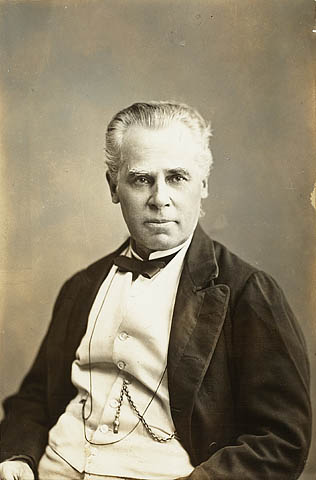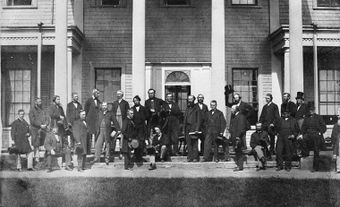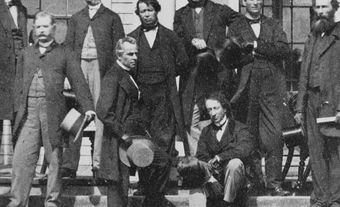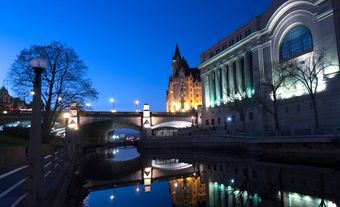
Background: Charlottetown Conference
The push for a union of Britain’s five North American colonies — the Province of Canada, New Brunswick, Prince Edward Island, Nova Scotia and Newfoundland — came mainly from Canada West. The legislature that governed both Canada West and Canada East had been deadlocked and unstable for years. Conservatives and reformers disagreed on many issues. Relations between the English in Canada West and the French in Canada East were tense.
Fears of American expansionism, combined with Britain’s increasing reluctance to defend its North American colonies, fuelled the desire for strength through unity. In 1864, a Great Coalition of Conservatives and reformers came together. They finally found solutions to end the political logjam in the Canadas. Among their goals was union with the other British North American colonies.
The idea of Confederation had been debated casually for years. It was formally discussed for the first time at the Charlottetown Conference in September 1864. That meeting was held by the three Maritime colonies to discuss their own political union. But it was transformed by a delegation from the Province of Canada, which came urging Confederation. The suggestion was seized upon and agreed to by all.
Quebec Conference
Many of the same delegates who met in Charlottetown (the Fathers of Confederation) gathered the next month in Quebec City. They met privately in a grand building overlooking the St. Lawrence River, where the Château Frontenac stands today. They talked, debated and socialized from 10–27 October.
Each of the 33 delegates were given sets of cards, the size of playing cards. The cards had the names and pictures of every participant, so people knew who was who.

Delegates
Delegates from Canada East included George-Étienne Cartier, Thomas D'Arcy McGee and Étienne-Paschal Taché. Taché, the Province of Canada’s prime minister, chaired the conference. George Brown and John A. Macdonald represented Canada West. John Hamilton Gray and Samuel Leonard Tilley were there from New Brunswick. Adams George Archibald and Charles Tupper came from Nova Scotia. George Coles and William Henry Pope represented Prince Edward Island. Newfoundland sent two men as observers — Frederic Carter and Ambrose Shea.
Distribution of Powers
One of the main questions at both the Charlottetown and Quebec conferences concerned the distribution of powers. Should the new country have a strong, or even a single, central government? Or should it be a more co-operative federal system with powers divided between national and provincial governments? John A. Macdonald called for a dominant, central government. He pointed to the breakdown of the US federal system and the resulting American Civil War as a cautionary tale. On the other hand, George-Étienne Cartier worried about francophone interests in Quebec, and Maritime leaders feared domination by the more populous central Canada. They both wanted a federal system with strong provincial governments.
A balance was reached. Powers would be divided between a central Parliament and provincial legislatures. This would create a federal union where the interests of regions and minority populations could be defended. The provinces would have control over education, language and municipalities, among other things. The federal government’s powers would include control over currency, international trade and criminal law. Some areas, such as immigration, would be shared. Both levels of government could raise taxes. (See also: Distribution of Powers.)

Regional Equality
The delegates decided that Parliament itself would have two houses. The lower house, or House of Commons, would consist of elected members. They would represent their provinces according to population. (See also: Rep by Pop.) There would be 82 seats for Ontario, 65 for Quebec, 19 for Nova Scotia and 15 for New Brunswick. (Prince Edward Island and Newfoundland did not join Confederation until 1873 and 1949, respectively. See also: Prince Edward Island and Confederation; Newfoundland and Labrador and Confederation.)
The upper house, or Legislative Council (now the Senate), would be appointed. Each region would have an equal number of seats in the Legislative Council, regardless of population. This was intended to safeguard regional interests. Each of the three regions — Ontario, Quebec, and the three Maritime provinces — would have 24 seats in the appointed chamber.
It was decided that Ottawa would be the capital. A provision was also made for other regions including Newfoundland, British Columbia and the “North-West Territory” (then called Rupert's Land). They could enter Confederation “on equitable terms” at a later time. It was also decided that the Crown, or the “Sovereign of the United Kingdom,” would remain the head of government and the keeper of “executive authority.” (See also: Sovereignty.)
The financial arrangements proposed by Alexander Galt also generated much discussion. A key issue was how the existing debts of the various colonies would be shared. The delegates agreed that the new federal government would help fund and finish construction of the Intercolonial Railway from Quebec City to the Maritimes. This was a key condition for the Maritimes’ entry into Confederation.

72 Resolutions
The delegates adjourned the conference on 27 October. Their decisions were embodied in 72 Resolutions, 50 of which were crafted by John A. Macdonald. He was one of the few delegates with legal and constitutional training. “As it is, I have no help,” Macdonald told Sir James Gowan. “Not one man of the conference (except Galt in financial matters) has the slightest idea of constitution making. Whatever is good or ill in the Constitution is mine.”
The 72 Resolutions, or Quebec Resolutions, were debated in various legislatures in the years to come. They went on to form the basis of Canada’s Constitution. In 1866 and 1867, they were turned into legislation by delegates at the London Conference, the final meeting in the Confederation process. That legislation became the British North America Act, which created the Dominion of Canada. It was passed by the British Parliament and became law on 1 July 1867. (See also: Canada Day.)
See also: Quebec Resolutions; Confederation: Timeline; Confederation: Collection; Fathers of Confederation; Fathers of Confederation: Table; Fathers of Confederation: Collection; Mothers of Confederation.

 Share on Facebook
Share on Facebook Share on X
Share on X Share by Email
Share by Email Share on Google Classroom
Share on Google Classroom





